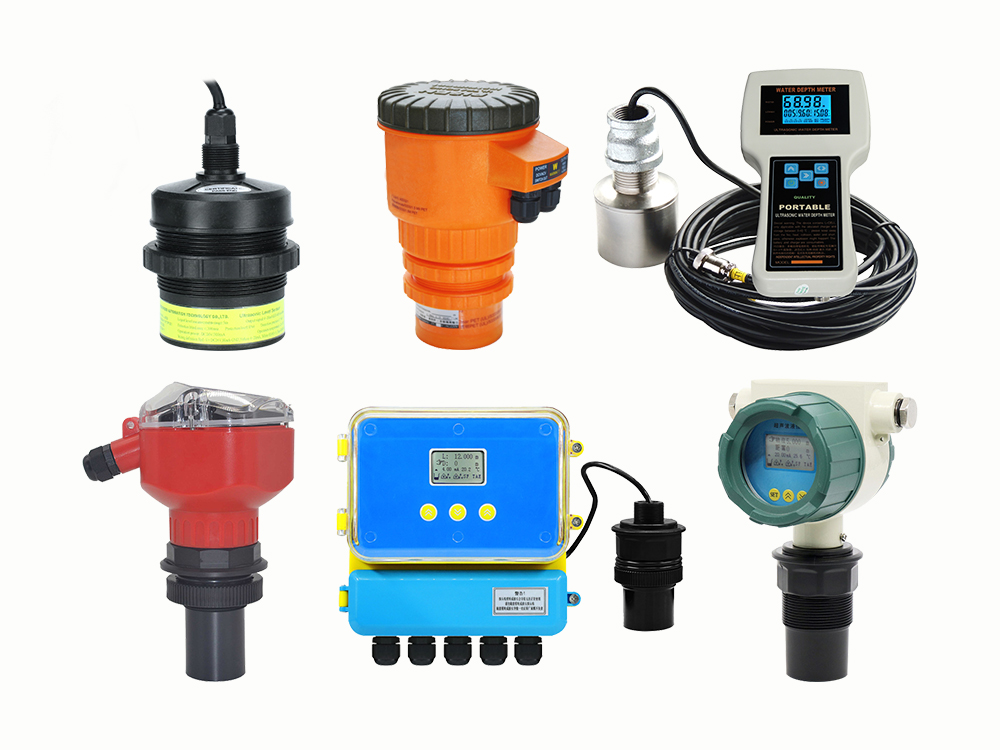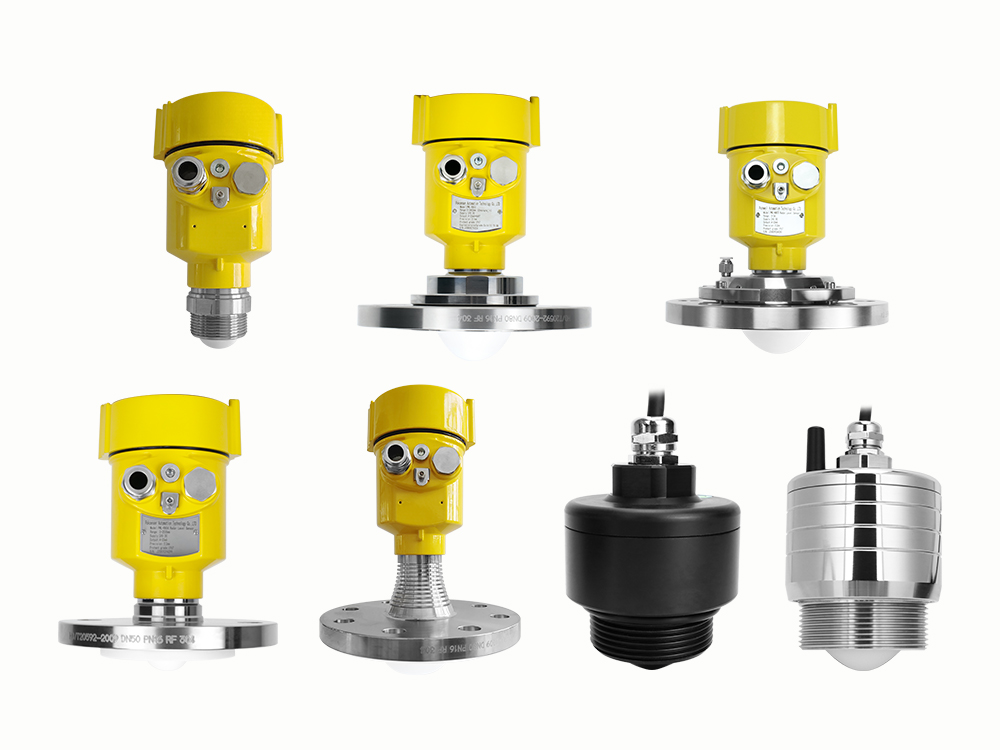Radar vs. Ultrasonic Level Sensors: A Selection Guide
In process automation, water management, environmental monitoring, and industrial storage applications, measuring liquid or solid levels is a critical task. Accurate level measurement ensures safety, efficiency, and cost control. Among the various non-contact level measurement technologies, radar sensors and ultrasonic level sensors are the most widely used.
Both sensor types are designed to measure the distance from a transmitter to the surface of a medium, but they operate using different principles—electromagnetic waves in the case of radar, and acoustic waves for ultrasonic technology. Each technology has unique strengths and limitations. This article serves as a practical selection guide, comparing ultrasonic level transmitters and radar level gauges to help engineers and plant operators choose the right solution for their application.
What are Ultrasonic Level Sensors?
Ultrasonic sensors operate on the principle of sound wave reflection. An ultrasonic transducer emits a high-frequency sound pulse toward the surface of a liquid or solid. The wave reflects back, and the sensor calculates the level by measuring the time of flight (ToF) of the echo.

Different Types of Ultrasonic Level Sensors
The Advantages of Ultrasonic Level Sensors
- Cost-effective solution for basic level monitoring.
- Non-contact measurement, suitable for corrosive or hazardous liquids.
- Simple installation and calibration.
The Limitations of Ultrasonic Level Sensors
- Accuracy depends on the propagation speed of sound, which varies with temperature, humidity, and gas composition.
- Performance may be affected by foam, vapor, or turbulence on the surface.
- Limited measurement range compared to radar.
Common configurations include ultrasonic level detectors, ultrasonic level transmitters, and ultrasonic distance sensors, which are widely applied in water treatment plants, environmental monitoring, and storage tanks.
What are Radar Level Sensors?
Radar sensors measure distance using microwave frequency electromagnetic waves. A radar antenna emits pulses or continuous waves, which reflect off the medium’s surface. The return signal is processed to determine the exact level.
Radar measurement technology can be divided into two main types: One is pulsed radar sensors: Short bursts of energy are transmitted and received, suitable for general-purpose applications. Another is Frequency Modulated Continuous Wave (FMCW) radar: Provides higher accuracy and better performance in challenging environments.
Another variant, Guided Wave Radar (GWR), uses a probe to guide the radar signal, making it suitable for complex media with foam or turbulence.

Industrial Radar Level Sensors for Liquid Measurement
The Advantages of Ultrasonic Level Sensors
High-precision radar sensing, unaffected by temperature, pressure, or vapor. Long measurement range, suitable for large tanks and silos. Reliable performance in harsh environments (high pressure, high temperature, steam, or dust). Minimal maintenance due to non-contact measurement.
The Limitations of Ultrasonic Level Sensors
Higher upfront cost compared to ultrasonic sensors. Requires correct antenna configuration and installation to avoid dead zones. Radar level sensors are widely used in industries such as oil & gas, chemicals, pharmaceuticals, and bulk solids handling, where accuracy and reliability are critical.
Key Comparison Factors Between Radar Sensors and Ultrasonic Sensors
Accuracy and Resolution
- Ultrasonic level measurement: Accuracy can be affected by environmental conditions such as temperature fluctuations and air composition. Typical accuracy ranges from ±0.25% to ±1% of the measured span.
- Radar level measurement: Provides higher accuracy, often better than ±0.1%, and is less affected by environmental disturbances. Ideal for applications where precision is essential.
Measurement Range and Medium Compatibility
- Ultrasonic sensors: Best suited for short-to-medium range applications, typically up to 10–20 meters.
- Radar sensors: Can measure much greater distances, up to 100 meters or more, making them ideal for tall silos and large storage tanks.
Environmental Adaptability
- Ultrasonic level transmitters: Performance may degrade in dusty, steamy, or foamy environments due to sound wave attenuation.
- Radar level gauges: Electromagnetic waves penetrate vapor, steam, and dust effectively, maintaining reliability in extreme process conditions.
Installation and Maintenance
- Ultrasonic level detectors: Easy to install and calibrate, making them attractive for simple monitoring needs. However, they may require occasional recalibration due to environmental sensitivity.
- Radar level transmitters: Installation requires consideration of antenna beam angle, mounting position, and tank geometry. Once installed, they are virtually maintenance-free.
Cost and Value
- Ultrasonic sensors: Typically the more affordable option, suitable when budget constraints exist and conditions are moderate.
- Radar sensors: Higher initial investment, but deliver better long-term value due to reliability, reduced downtime, and low maintenance requirements.
Application Scenarios of Ultrasonic Sensors and Radar Sensors
Water and Wastewater Treatment
- Ultrasonic sensors are commonly used in open-channel flow measurement, small tanks, and wastewater monitoring due to their cost-effectiveness.
- Radar sensors are preferred in harsh wastewater environments with heavy foam, vapor, or temperature variations.
Chemical and Pharmaceutical Industries
- Radar level transmitters are often chosen for their chemical resistance and ability to handle pressurized or corrosive tanks.
- Ultrasonic sensors may still be used in non-critical, small-scale applications.
Grain Silos and Bulk Solids
- Dust and uneven surfaces can disrupt ultrasonic measurement.
- Radar level gauges with high penetration capability are better suited for grain storage and powder handling.
Oil, Gas, and Petrochemical
- Radar sensors are the standard for measuring in large storage tanks, pressurized vessels, and LNG applications, where reliability under extreme conditions is essential.
Environmental Monitoring and Rivers
- Ultrasonic sensors are commonly used for river level and flood monitoring due to their affordability and simple setup.
- In challenging outdoor conditions, radar sensors offer greater durability and consistent performance.
Selection Guide of Ultrasonic Sensors and Radar Sensors
Here is a simple decision framework to help choose between the two technologies:
Choose ultrasonic sensors if:
- Budget is limited.
- The measurement range is short to medium.
- The environment is relatively clean and stable.
- Moderate accuracy is acceptable.
Choose radar sensors if:
- High accuracy is required.
- The process involves vapor, steam, foam, dust, or extreme temperatures.
- The measurement distance is long.
- Maintenance-free operation is a priority.
Conclusion
Both radar level sensors and ultrasonic level sensors are proven, non-contact technologies for accurate level measurement. Ultrasonic sensors are valued for their affordability, simplicity, and suitability for basic applications. Radar sensors, while more expensive, deliver superior accuracy, reliability, and environmental adaptability, especially in complex industrial processes.
When selecting between the two, the choice should be guided not by the technology itself but by the specific application requirements—including accuracy, environmental conditions, measurement range, and budget.
Ultrasonic sensors are ideal for simple and cost-sensitive tasks, while radar sensors are the go-to solution for critical, high-performance applications.
Need More Help? Contact us Now!
FAQ: Radar vs. Ultrasonic Level Sensors
Q1. What is the main difference between radar level sensors and ultrasonic level sensors?
A: Radar sensors use electromagnetic waves (microwaves) to measure levels, while ultrasonic sensors rely on acoustic sound waves. Radar offers higher accuracy and better performance in harsh environments, whereas ultrasonic sensors are more cost-effective for simple applications.
Q2. Which sensor is more accurate: radar or ultrasonic?
A: Radar sensors are generally more accurate, often within ±0.1%. Ultrasonic sensors usually achieve ±0.25% to ±1%, but their accuracy can be affected by temperature, humidity, and surface conditions.
Q3. Can ultrasonic sensors work in environments with steam or foam?
A: Ultrasonic sensors can struggle with steam, vapor, dust, or foam because these factors interfere with sound wave reflection. Radar level gauges are better suited for such challenging environments.
Q4. Are radar sensors always better than ultrasonic sensors?
A: Not necessarily. Radar sensors are more robust and precise, but they are also more expensive. Ultrasonic level detectors are sufficient for short-range, clean, and cost-sensitive applications such as water treatment or river monitoring.
Q5. What is the typical measurement range of ultrasonic vs. radar sensors?
A: Ultrasonic sensors typically measure up to 10–20 meters, while radar sensors can measure up to 100 meters or more, making them suitable for tall silos or large tanks.
Q6. Do radar sensors require more maintenance than ultrasonic sensors?
A: No. In fact, radar level transmitters are often maintenance-free once properly installed. Ultrasonic sensors may need recalibration if environmental conditions change.
Q7. Which industries commonly use radar level sensors?
A: Radar sensors are widely used in oil & gas, petrochemical, chemical, pharmaceutical, and bulk solids industries, where accuracy and reliability in harsh environments are critical.
Q8. When should I choose ultrasonic level sensors over radar?
A: Choose ultrasonic sensors when: The environment is stable and clean. The measurement distance is short-to-medium. The budget is limited. Only moderate accuracy is required.
Q9. How is guided wave radar (GWR) different from standard radar sensors?
A: Guided wave radar uses a probe or rod to guide the radar signal directly into the medium, improving performance in foamy, turbulent, or low dielectric constant materials where standard radar may face challenges.
 English
English Spanish
Spanish
